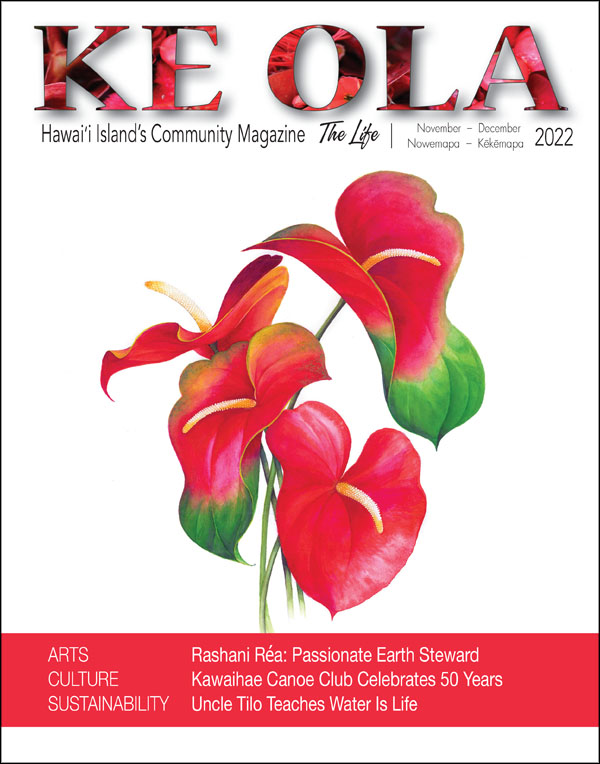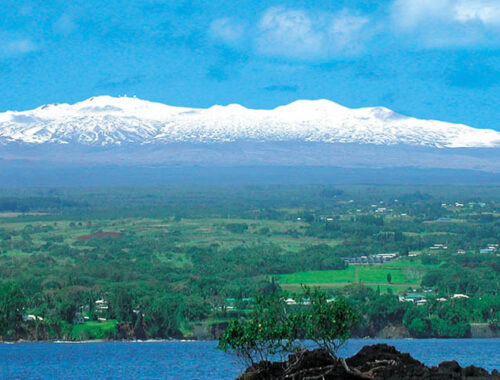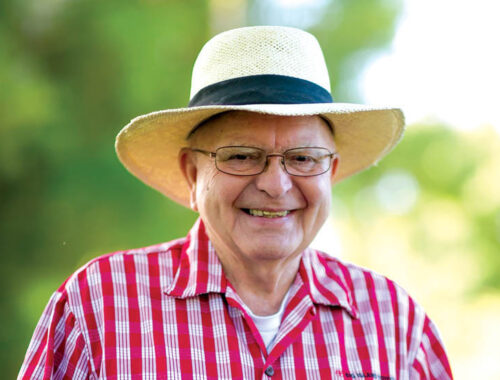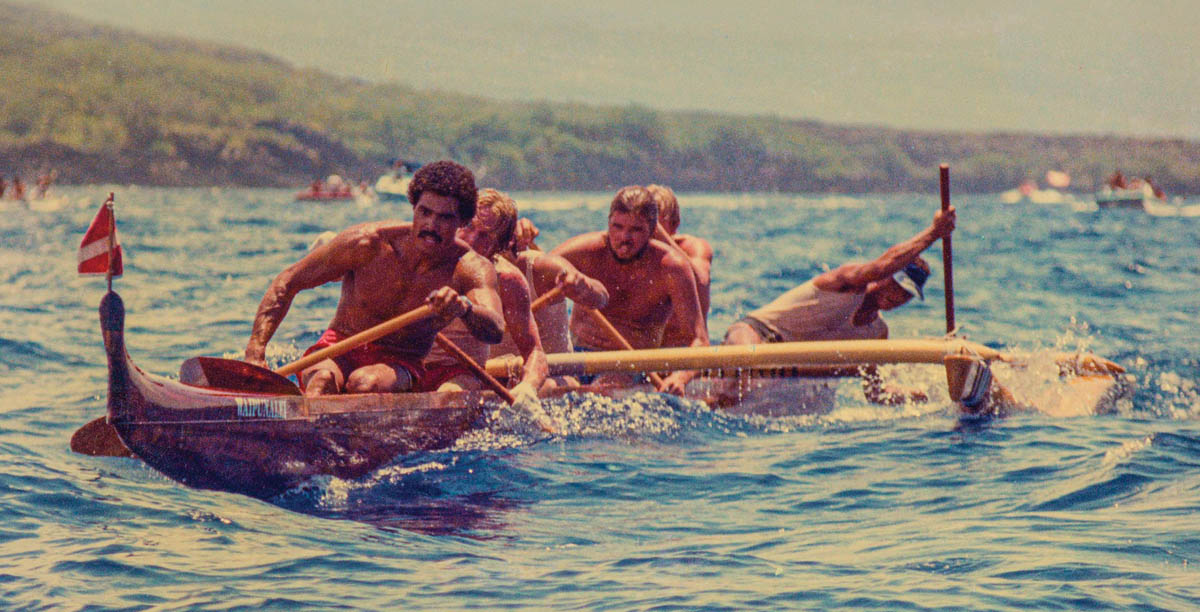
Kawaihae Canoe Club Celebrates 50 Years

By Jan Wizinowich
It’s early morning at Kawaihae and outrigger canoes dot the horizon carrying the kūpuna paddlers. Soon, the men’s master crew will be gliding into the boat ramp after an early morning run heading north. A Matson barge approaches the harbor, a cubist two-story structure. Many things have changed in this little corner of the island, but as always, Uncle Manny Veincent, Kawaihae Canoe Club (KCC) president and head coach, is a presence at the club—doing repairs, checking inventory and making sure everything is pono (right).
November 2022 is the 50th anniversary of KCC, and while not the oldest club on the island, it is a cultural treasure within historic Kawaihae Village. With its fresh water spring, rich reef and calm anchorage, Kawaihae was a center of activity in old Hawai‘i. It is the place where Kamehameha gained final dominance over Moku o Keawe and where he resided while making plans to unite the islands.
Evidence of the “make strong” spirit of King Kamehameha resides in Kawaihae, channeled through Manny and the many men and women who stroked KCC to state championships, conquered ʽAlenuihāhā and Kaʽiwi Channels and paddled the Kuhio Day Long Distance Race on Kaua‘i.
Origins
Manny grew up in Keaukaha, Hilo, where life was simple and of the land. His canoeing adventures started when he was 13 and a neighbor took him along with a gang of boys paddling, fishing, and camping in an old-style koa canoe.
In 1972 Manny was fire chief, stationed in Waimea (where the Firehouse Gallery is now) when Elaine Flores, Mabel Tolentino, and members of the Hawaiian Civic Club approached him to help form a canoe club in Kawaihae.
KCC was formed in 1972, when canoe paddling was experiencing a resurgence. The Moku ʽO Hawaiʽi Canoe Racing Association (MOHCRA) was created in 1973, and in addition to Kawaihae, there were seven other active clubs.
“When the club first started, folks at Kawaihae didn’t know anything about paddling. The club was just that white hill over there and we had a big keawe tree and a shed next to the road,” remembers Eunice Veincent, who is still paddling at 86. But there was no shortage of members, who came from Kohala, Waimea, Honokaʽa, and even Paʽauilo, more than 200 strong.
That first year Kawaihae surprised everyone when they won the first race of the season, which took place in home waters. They went on to win the state championship that year and the next three years. It was all due to hard work. “We had only one practice in the afternoon. We’d start at 4pm with the kids, and then the adults. We didn’t finish practice until 8:30pm,” said Eunice.
It’s All About the Keiki
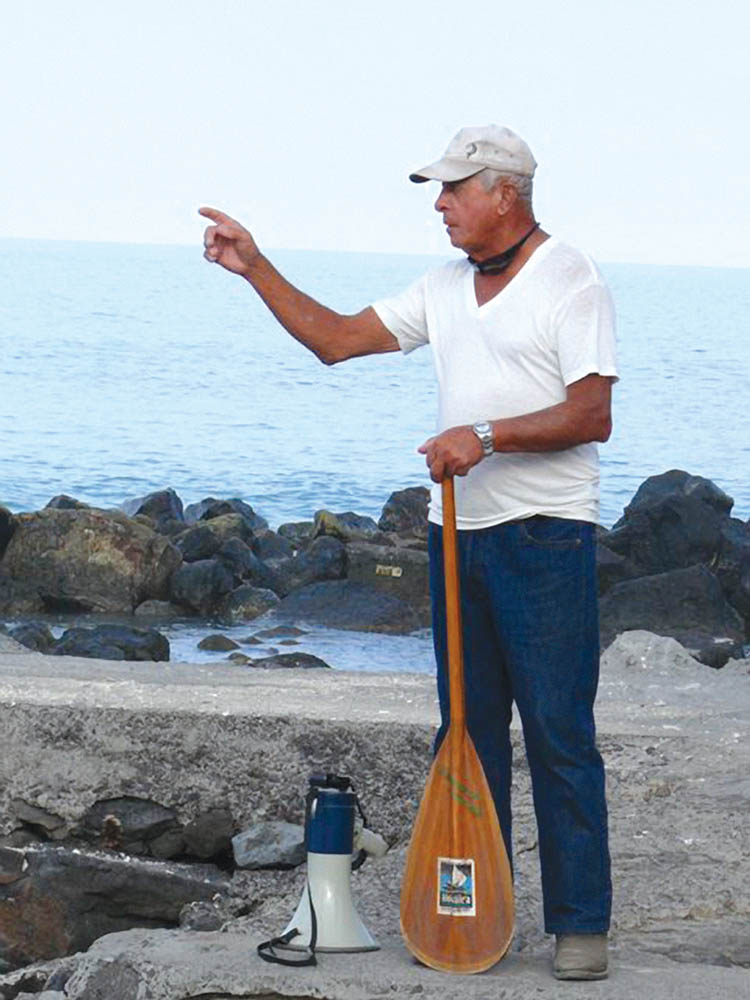
Now young paddlers have van transportation, but back in the day Manny and Eunice would stop and pick up kids on their way down to practice every day. Manny also coached Pop Warner football and in his own inimitable style recruited paddlers for the off-season.
“When I was a little kid we used to play Pop Warner football for Manny. At the end of the season, he gave us all this paper and said, ‘Don’t worry about it. Just take it home.’ So, we took it home and got the signatures and what it was, he was signing us up with canoe paddling,” remembers Jerry Bess, a top surfer who started at the age of 10 and paddled with KCC for 12 years.
Historically canoes were considered providers for their island community. In current times, the canoe feeds the community in ways that go beyond food.
“For us young guys, Manny really showed us how to work as a team. Accountability, training hard, helping out each other. Commitment, club orientation, getting there on time, helping out with the canoe. He worked us so hard. It was us 16s all the way up to the 18s, we were undefeated. It was because of Manny’s coaching,” said Jerry.
More than winning races, KCC has provided a cultural link that’s been a lifeline for youngsters and the community as a whole. This was the spirit of the club fostered by the willingness of Coach Manny and his wife, Eunice, to give their all for the paddlers.
“We would stay down there on Saturdays and we’d take canoes out on Sunday and Eunice would feed all of us. That’s how we all learned to steer as kids. Today, you look at the top steersmen, they grew up with us. They’re from Kawaihae,” remembers Grant Kaʽaua, who now coaches paddling at Keaʽau High School and whose daughter, Pakelakahiki, is a top steersperson and got her start at KCC.
Manny’s other love is ranching and Nienie Ranch, his 300-acre ʽĀhualoa mauka cattle operation has provided off-season fitness training for many of the paddlers, as well as giving them confidence.
“Some of my fondest memories are KCC ‘cross-training’, which involved going to Manny’s ranch and tackling 1000-pound bulls—without the help of horses. And then castrating them and branding them,” said Grant.
The Wahine
Beyond regatta wins, the KCC women “made strong” at the Kauaʽi Kuhio Day Long Distance Race in 1989 and 1990. Crew member Ululani Patterson Odell remembers, “We could hear the waves breaking on shore from where we were staying. Once there, we could see the waves and they were a heart stopper. We paddled out to the wave, went up and back down with a slam. But once we got going, everything clicked. You had to be ready for this race mentally and physically. Manny prepared us for both.”
In 2004, 2007, and 2010 a team of 18 Kawaihae women paddled across the ʽAlenuihāhā Channel for the first time in over a century. The planning and training leading up to the first crossing took two to three years and demanded complete commitment. It was not just a sport, but a spiritual connection.
“There’s something so powerful. The old Hawaiians call it spirit or mana. It goes deeper than the physical. You do it and a brilliant light opens up and you gain all this knowledge,” remembers Manny.
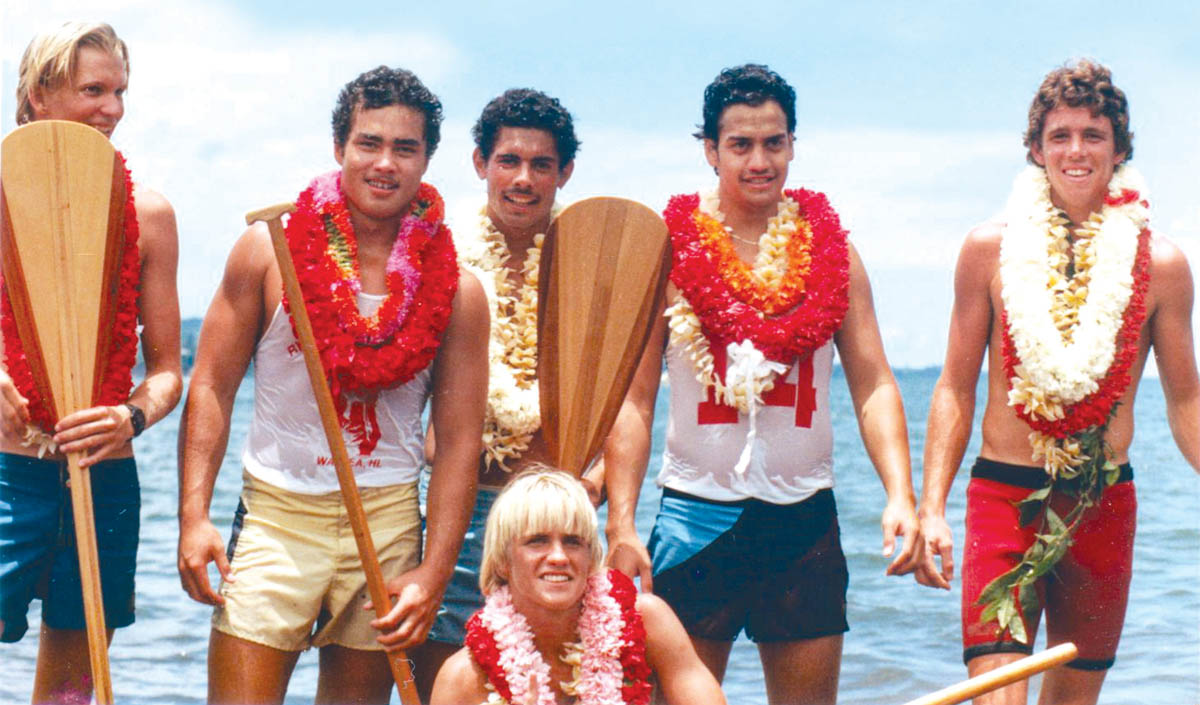
The Koa Canoes of KCC
Everything Manny does originates from a well-lived life grounded in Hawaiian culture. Beyond coaching, he is a master canoe builder and has led the way in every stage from harvesting the logs to design and building.
In 1975, Moku ʽO Hawaiʽi Canoe Association (MOHCRA) mandated that all clubs use koa canoes for racing by 1980. In 1977, two logs, gifts from Richard Smart, were harvested from Parker Ranch land, Laupāhoehoe mauka. They were transported to KCC where Manny was joined by Harry Fergerstrom, Frank Puhi, Kahu William Akau, and others to birth Kai Hawanawana (Whispering Sea), the club’s first koa canoe. She was followed in 1982, by Waipunalei (named after the area where the logs came from).
Another koa canoe, Leimomi, was added early in 1982, donated by the DeGuair family and named in honor of John DeGuair Jr’s widow, Grace. Sadly, in November 1982, Hurricane Iwa swept in, destroying the shed and both Leimomi and Waipunalei.
The club’s current canoe, Waihou, was constructed from a log donated by F. Newell Bohnett, then-owner of Puʽu Waʽawaʽa Ranch and named after the area where it originated on the shoulder of Hualālai. Begun at the club, Waihou was sent to Sand Island to be finished by master canoe builder, Tay Perry, and ultimately christened around 2015.
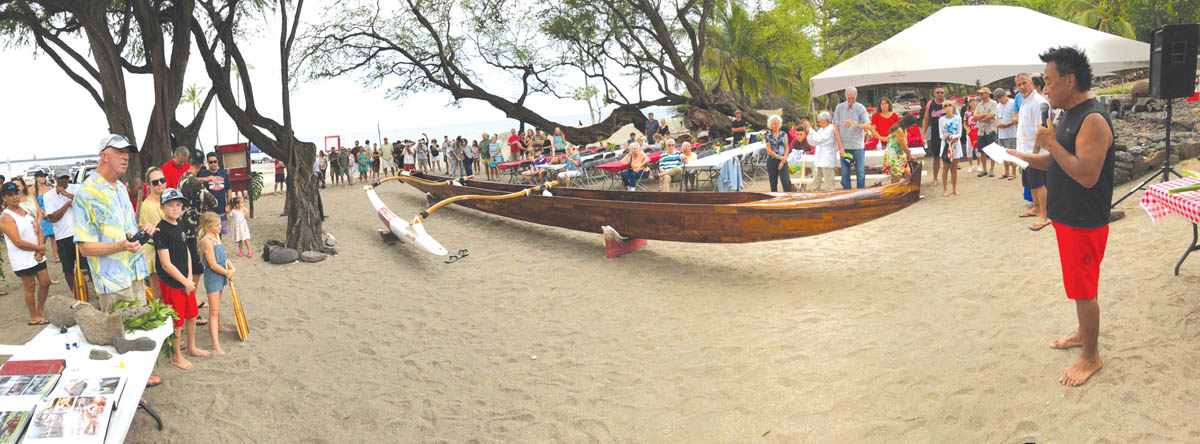
Kūpuna
About 20 years ago, a group of paddlers made up of Steve Bess, George Fry, Roger Harris, Harry Buscher, Charlie Campbell, Michael Bates, Phyllis Fox, and others, decided to slow things down a little. They began paddling three days a week. “We wanted to just have fun. Paddle to the Mauna Kea [Hotel] and talk story,” remembers George Fry.
Now the group has mushroomed into two groups of three or four canoes that go out at different times and has proved to be a great introduction to Hawaiian culture. The kūpuna group has also developed into a fundraising source for the club, making it possible for the keiki to participate off-island and to add canoes and other equipment to the club.
Legacy
Over the years, Manny and thousands of club members have kept the culture alive. Not just through paddling, but by creating an oasis of abundance and a place to come together, old style, like the annual hoʽolauleʽa.
“I joined the club in 1998 and learned a lot along the way from Manny about building canoes, rigging canoes, fixing canoes, and medicinal Hawaiian plants. We have five acres and most of it was overgrown with dead keawe and weeds. I asked Manny if it would be ok if we clean it and plant native Hawaiian plants. So, I took it on as a project but Manny took on the leadership,” recalls Bob Momson.
KCC’s lasting legacy is all the people that have received life-changing help along the way. There are numerous stories, told and untold, about the positive effects of Manny and KCC. “I cannot thank Manny enough. He’s a pivotal person in so many of our lives. I just love him for the character he is. I appreciate so much his hard-nose ways, and his huge heart. He’s taught us so much; how to take care of everything,” concludes Grant. ❖
All photos courtesy of kūpuna paddler George Fry
For more information: kawaihaecanoeclub.com
